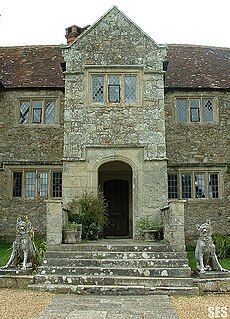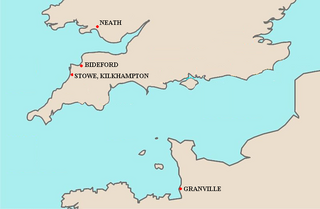Related Research Articles

Dibden is a small village in Hampshire, England, which dates from the Middle Ages. It is dominated by the nearby settlements of Hythe and Dibden Purlieu. It is in the civil parish of Hythe and Dibden. It lies on the eastern edge of the New Forest in a valley, which runs into Southampton Water.

Aldringham is a village in the Blything Hundred of Suffolk, England. The village is located 1 mile south of Leiston and 3 miles northwest of Aldeburgh close to the North Sea coast. The parish includes the coastal village of Thorpeness. The mid-2005 population estimate for Aldringham cum Thorpe parish was 730.

Quarr Abbey is a monastery between the villages of Binstead and Fishbourne on the Isle of Wight in southern England. The name is pronounced as "Kwor". It belongs to the Catholic Order of St Benedict.

Nuneham Courtenay is a village and civil parish about 5 miles (8 km) southeast of Oxford. It occupies a pronounced section of the left bank of the River Thames.

de Lacy is the surname of an old Norman family which originated from Lassy, Calvados. The family took part in the Norman conquest of England and the later Norman invasion of Ireland. The name is first recorded for Hugh de Lacy (1020–1085). His sons, Walter and Ilbert, left Normandy and travelled to England with William the Conqueror. The awards of land by the Conqueror to the de Lacy sons led to two distinct branches of the family: the northern branch, centred on Blackburnshire and west Yorkshire was held by Ilbert's descendants; the southern branch of Marcher Lords, centred on Herefordshire and Shropshire, was held by Walter's descendants.

The title Baron Grey of Powis (1482–1552) was created for the great-grandson of Joan Charleton, co-heiress and 6th Lady of Powis (Powys) and her husband, Sir John Grey, 1st Earl of Tankerville (1384–1421) after the death of Joan's father, Edward Charleton, 5th Baron Cherleton (1370–1421) left the title in abeyance.
The Lord of the Isle of Wight was a feudal title, at times hereditary and at others by royal appointment in the Kingdom of England, before the development of an extensive peerage system.

Umberleigh is a former large manor within the historic hundred of (North) Tawton, but today a small village in North Devon in England. It used to be an ecclesiastical parish, but following the building of the church at Atherington it became a part of that parish. It forms however a part of the civil parish of Chittlehampton, which is mostly located on the east side of the River Taw.

Arlescote is a village in Warwickshire, England.

Seacourt is a deserted medieval village near the City of Oxford. The site is now mostly beneath the Oxford Western By-pass, about 0.3 miles (0.48 km) south of the Seacourt / Hinksey Stream crossing.

Isabel de Forz was the eldest daughter of Baldwin de Redvers, 6th Earl of Devon (1217–1245). On the death of her brother Baldwin de Redvers, 7th Earl of Devon in 1262, without children, she inherited suo jure the earldom and also the feudal barony of Plympton in Devon, and the Lordship of the Isle of Wight. After the early death of her husband and her brother, before she was thirty years old, she inherited their estates and became one of the richest women in England, living mainly in Carisbrooke Castle on the Isle of Wight, which she held from the king as tenant-in-chief.

Arreton Manor is a manor house in Arreton, Isle of Wight, England. Its history is traced to 872 AD to the time of King Alfred the Great and his parents. It was left by King Alfred by his will to his youngest son Aethelweard. Once owned by William the Conqueror, as mentioned in the Domesday Book in 1086, in the 12th century it became part of Quarr Abbey and was used by the monks for over 400 years. In 1525, it was leased to the Leigh family. The manor was rebuilt between 1595 and 1612. Built in Jacobean style, it is in the shape of a "H". It is also widely known on the Isle of Wight in folklore for its paranormal activity, particularly the ghost of a young girl named Annabelle Leigh who was allegedly murdered at the manor by her own brother in 1560.
Chillingwood Manor is a manor house on the Isle of Wight, situated within the Newchurch parish.
Bigbury Manor is a small manor house on the Isle of Wight within the Newchurch parish. It is a small holding to the north of Apse Heath, was confirmed to Quarr Abbey by Isabel de Fortibus, and remained in the possession of the abbey until the Dissolution of the monasteries, when it passed to the Crown. It was granted in 1610 to Lionel Cranfield,. In 1631 Basil Nicoll and others obtained a grant of the messuage or grange of Bidborowe.
The Manor of Dyrham was a former manorial estate in the parish of Dyrham in South Gloucestershire, England.
The Feudal Barony of Berry Pomeroy was one of eight feudal baronies in Devonshire which existed during the mediaeval era, and had its caput at the manor of Berry Pomeroy, 20 miles south of the City of Exeter and 2 miles east of the town of Totnes, where was situated Totnes Castle, the caput of the feudal barony of Totnes. The exact location of the 11th-century baron's residence is unclear, perhaps it was next to the parish church on the site of the present former rectory known as Berry House, as it is now believed that the present surviving nearby ruined Berry Pomeroy Castle was not built until the 15th century.
Eversley Manor is a manor in Eversley, Hampshire, England. Mentioned in the Domesday Book, in 1669, it was purchased by Sir Andrew Henley of Bramshill House, who then ran it.

Sir Richard de Grenville was one of the Twelve Knights of Glamorgan who served under Robert FitzHamon, in the conquest of Glamorgan in Wales. He obtained from FitzHamon the lordship of Neath in which he built Neath Castle and in 1129 founded Neath Abbey. He is by tradition the founder and ancestor of the prominent Westcountry Grenville family of Stowe in the parish of Kilkhampton in Cornwall and of Bideford in Devon, the later head of which family was John Granville, 1st Earl of Bath (1628–1701). The surname of his supposed descendants the Westcountry Grenville family was spelled by tradition "Grenville" until 1661 when it was altered to "Granville".

Milton Abbot is a village, parish, and former manor in Devon, 6 miles (9.7 km) north-west of Tavistock, Devon, and 6 miles (9.7 km) south-east of Launceston, Cornwall.
References
This article includes text incorporated from William Page's "A History of the County of Hampshire: Volume 5 (1912)", a publication now in the public domain